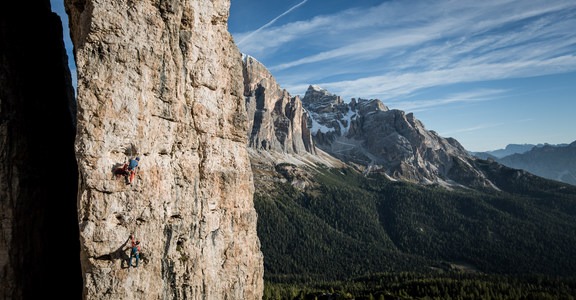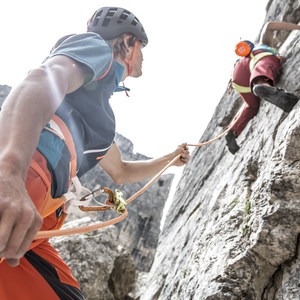Belay methods
When climbing, the rope team literally has their climbing partner’s life in their hands. Mastering the partner's belay in every situation is therefore of extraordinary importance. The anchor is the safe haven for a rope team. As the central protection point in the climb, it must be able to withstand the lead or follower falling. It is therefore extremely important that all alpine climbers can quickly and securely set up a clear anchor. This depends upon the current conditions, such as the number and quality of anchors, their position in relation to one another and the belay method.
In alpine terrain, we differentiate between three different belay methods: body belay, anchor belay, and central point belay in a distribution of load. We'll cover the body belay here.
Body belay
When using body belaying, the belayer is part of the belay chain: The belay device for the lead climber is clipped onto the belay ring on the harness. With body belays, it is possible to be belayed directly and with less slack rope. The disadvantage of body belays is that the climber is part of the belay chain and the braking distance and fall distance are greater, as in the event of a fall the belayer is pulled upwards.
The climber must have experience of body belays before using them, and the difference in weight between the climbers must not be too great. A dummy runner must also be clipped onto the belay. The dummy runner will prevent a falling individual from falling onto the belayer: It provides protection that – in the event of a belay fall – ensures that the fall tension in the belay device will act upwards and the belayer can stop the fall.
Dynamic or semi-automatic devices can be used as protecting devices. Body belaying is recommended if the following points are guaranteed:
- The fall tension acts upwards, not to the side (transverse) or downwards.
- The belayer can be pulled upwards and will not collide with an overhang.
- The belayer has sufficient space in which to brake, and has a long personal anchor sling.
- The protection points available are good (bolts) and at acceptable intervals (maximum of three to five meters). The maximum possible fall energy remains manageable
- The belayer is accustomed to preventing falls using their body and the belayer and the climber have a similar weight.
Anchor belay
In an anchor belay, the belay device is hooked into the center of the anchor. The central point can be a locked carabiner, a bowline on a bight or even a quick link on the anchor bolt. A dynamic device (HMS/ATC) must be used as a belay device.
An anchor belay requires a solid anchor, as fall tension can be exerted on the anchor in any direction. The advantage of this belay is that the climber is not part of the belay chain and therefore no forces are exerted upon him/her. If an anchor belay is used, in the event of a fall the braking distance is shorter and therefore the total fall distance is shortest. The disadvantage is that, because of the shorter braking distance, the impact of the falling climber against the rock face can be harder.
Central point belay in a distribution of load
In a central point belay in a distribution of load, the belay is at a point between the anchor and body. It is used if there are no reliable anchors available at the belay (no bolts), or if the climber is working with removable traditional climbing gear for anchors. In this case, two to five anchors are to be connected in such a way that all of them can absorb the fall energy to the central point at the same time. If one of the anchors gives, there is no additional force added to the system (jerking). The ideal way of setting up such belays is with the “South Tyrolean method.” This involves using a locking carabiner with a girth hitch as the central point, thus avoiding a tangle.
If possible, the central point should not be braced, as in the event the belay fails the belayer may crash into the wall. If this is not possible, the belayer must accept there is the possibility of being yanked upwards.
Check out the full series of Safety Academy Lab Rock videos below:
- Alpine basics
- Basic equipment for every climber
- Basic equipment for groups
- Additional equipment for groups
- Storms in the mountains
- Types of rock in the Alps
- Tour planning for alpine climbing
- Packing a backpack correctly
- Rope team procedures
- Knot techniques
- Belay using bolts
- Belay methods
- Anchors
- Coiling a climbing rope
- Rappelling
- What to do in an alpine emergency
- First aid on the mountain
- Rescue techniques while alpine climbing
- Bivouacking in an emergency situation
Visit ORTOVOX’s Safety Academy Lab Rock to view the climbing tutorials in their totality and test your knowledge with their fun and interactive quizzes.
Since the company was founded in 1980 in the south of Munich, ORTOVOX has stood for the highest possible protection during alpine activities. As pioneers in the avalanche safety field, we have played a key role in the development of emergency equipment for the mountains. Innovations such as the double-frequency avalanche transceiver and Smart Antenna Technology, and also targeted training measures, continue to be valuable contributions to making mountain sports a little bit safer and to saving lives.






Comments
Sign In and share them.